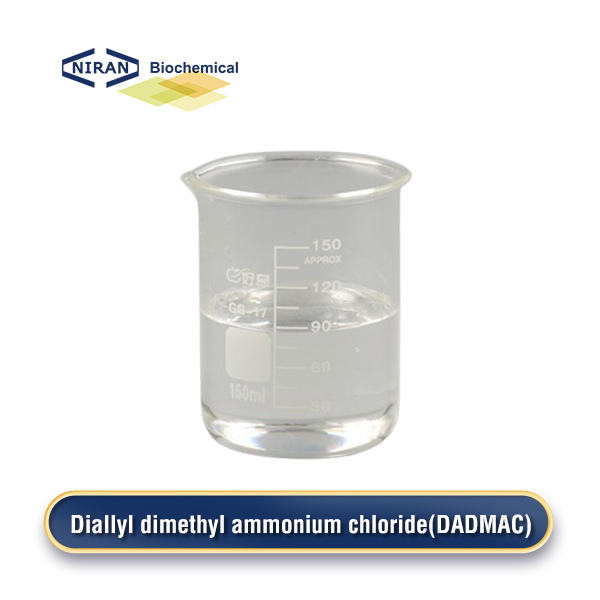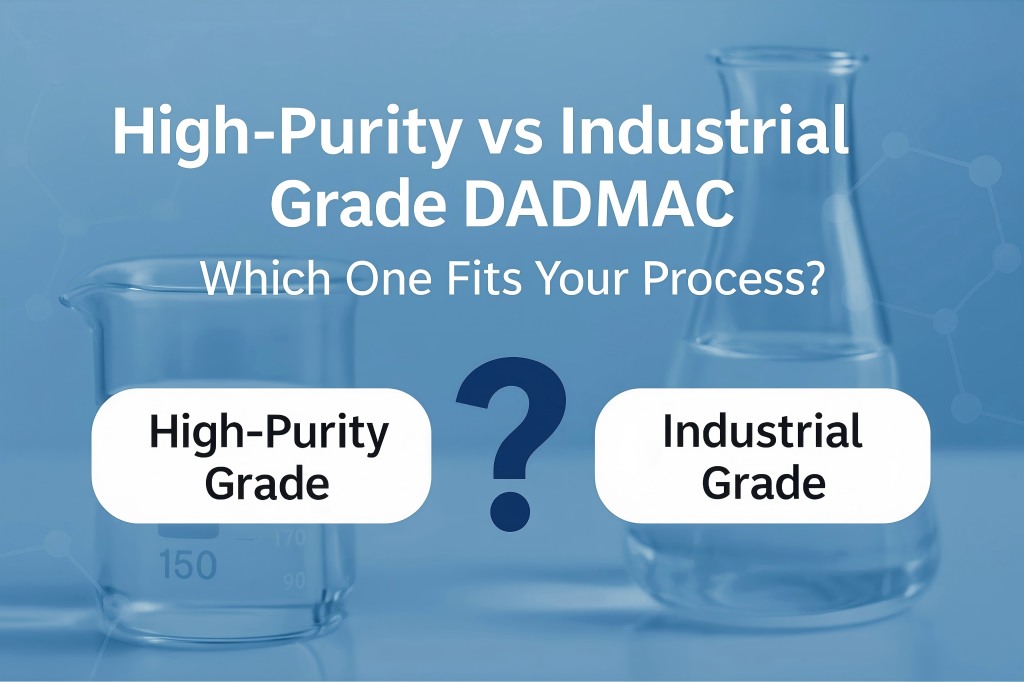Diallyl Dimethyl Ammonium Chloride (DADMAC) is a key component in various industrial and commercial formulations, serving as a highly reactive, water-soluble cationic monomer. DADMAC, which comes in a variety of purity grades, is used in anything from high-end cosmetic formulations to municipal water treatment.
The decision to use high-purity versus industrial-grade DADMAC involves a complex trade-off between performance, cost, safety, and regulatory compliance. In this article, we explore everything manufacturers, formulators, and procurement teams need to know when selecting the right DADMAC grade for their process.
What Is DADMAC and How Is It Used in Industry?

DADMAC (C₈H₁₆ClN) is a quaternary ammonium compound with a strong cationic charge. Its molecular structure includes two allyl groups and a permanently charged nitrogen atom, enabling it to polymerize easily via free-radical initiation. This makes it exceptionally suitable for use in the production of homopolymers (like PolyDADMAC) and copolymers with acrylamide or other vinyl monomers.
DADMAC is used widely in:
Water treatment: As a coagulant precursor for removing suspended solids, turbidity, and organic contaminants.
Papermaking: Improves wet strength, filler retention, and dewatering processes.
Textile finishing: Acts as a dye-fixing agent and antistatic additive.
Cosmetics and personal care: Provides conditioning, emulsifying, and antistatic properties in hair care and skincare products.
Oilfield applications: Breaks emulsions and facilitates solid-liquid separation.
Adhesives and coatings: Used in high-performance cationic latex systems.
Defining Purity: What Separates High-Purity from Industrial Grade DADMAC?
The distinction between high-purity and industrial-grade DADMAC centers on impurity levels, residual monomer content, appearance, and compliance with health and safety standards.
Industrial Grade DADMAC contains higher levels of residual monomers, chlorinated by-products, and coloration. It’s typically yellowish, has a faint odor, and is not suitable for applications involving direct human contact or stringent regulatory oversight.
High-Purity DADMAC (typically ≥90%) undergoes additional purification steps to reduce residual monomers to <500 ppm, minimize chlorinated impurities, and ensure colorless, odor-free material. In delicate applications like electronics, medications, and cosmetics, this grade is necessary.
Typical Concentration Levels: 60%, 70%, 80%, and ≥90% Compared
DADMAC is typically supplied as an aqueous solution in concentrations ranging from 60% to over 90%. Each concentration has its own application relevance and pricing structure.
| Concentration | Purity Grade | Application Focus |
| 60% | Industrial Grade | Water treatment, oilfield demulsifiers, basic textile processing |
| 70% | Technical Grade | Papermaking, emulsion polymers, intermediate-quality textile uses |
| 80% | Technical Grade | Retention aids, high-performance coatings |
| ≥90% | High-Purity Grade | Cosmetics, pharmaceuticals, personal care, electronics |
Advantages of Industrial Grade DADMAC
Industrial-grade DADMAC offers practical advantages for large-scale and cost-driven operations:
- Cost efficiency
- Readily available
- Good functional efficacy
- Lower regulatory burden
- Faster procurement cycles
While impurities may limit its use in high-value formulations, industrial-grade DADMAC provides sufficient functionality for applications where aesthetics and purity are less critical.
Benefits of High-Purity DADMAC for Sensitive Applications
High-purity DADMAC is essential for applications with direct human contact or stringent quality controls. Its advantages include:
- High safety profile
- Superior clarity and odor profile
- Stable polymerization behavior
- Extended shelf life
- Meets regulatory criteria
For companies developing personal care, pharmaceutical, or biomedical products, high-purity DADMAC is often a non-negotiable requirement.
Industry Use Cases: Where Each Grade Performs Best
Industrial Grade DADMAC (60–70%)
- Municipal wastewater treatment
- Textile processing
- Pulp and paper
- Oil and gas
High-Purity DADMAC (≥90%)
- Cosmetic and personal care
- Pharmaceutical polymers
- Food packaging adhesives
- Electronics and semiconductors
Impact on Polymerization and Product Quality
Purity plays a direct role in polymer behavior and product output:
- Impurities inhibit polymerization
- Molecular weight control
- Charge density
- Aesthetic impact
In cosmetic emulsions, color consistency and texture uniformity are non-negotiable. In water treatment, efficiency is prioritized, but color and odor are less relevant.
Compliance and Regulatory Considerations by Grade
| Grade | Regulatory Status |
| Industrial Grade | MSDS available, not REACH or FDA compliant |
| Technical Grade | May require additional testing and compliance certifications |
| High-Purity Grade | Fully REACH registered, INCI listed, FDA acceptable, and GMP-compliant |
Formulators must ensure that their DADMAC source complies with the regulatory scope of their intended markets.
Cost vs Performance: How to Balance Quality and Budget
Making the right grade selection involves balancing procurement cost with value added by purity:
| Criteria | Industrial Grade | High-Purity Grade |
| Cost per kg | Lower | Higher |
| Required purity | Moderate | Extremely high |
| Visual appearance | Yellowish | Clear, colorless |
| Odor | Slightly pungent | Odor-free |
| End-use sensitivity | Low | High |
| Compliance burden | Low | High |
| Performance consistency | Variable | Consistent |
Choosing the Right DADMAC Grade for Your Process
When selecting a DADMAC grade, consider the following steps:
- Clarify the end-use
- Assess performance requirements
- Understand market expectations
- Review budget constraints
- Request full documentation from the supplier
Often, the decision is not binary. Some manufacturers use a blend of grades or tiered product lines depending on application and market segment.

